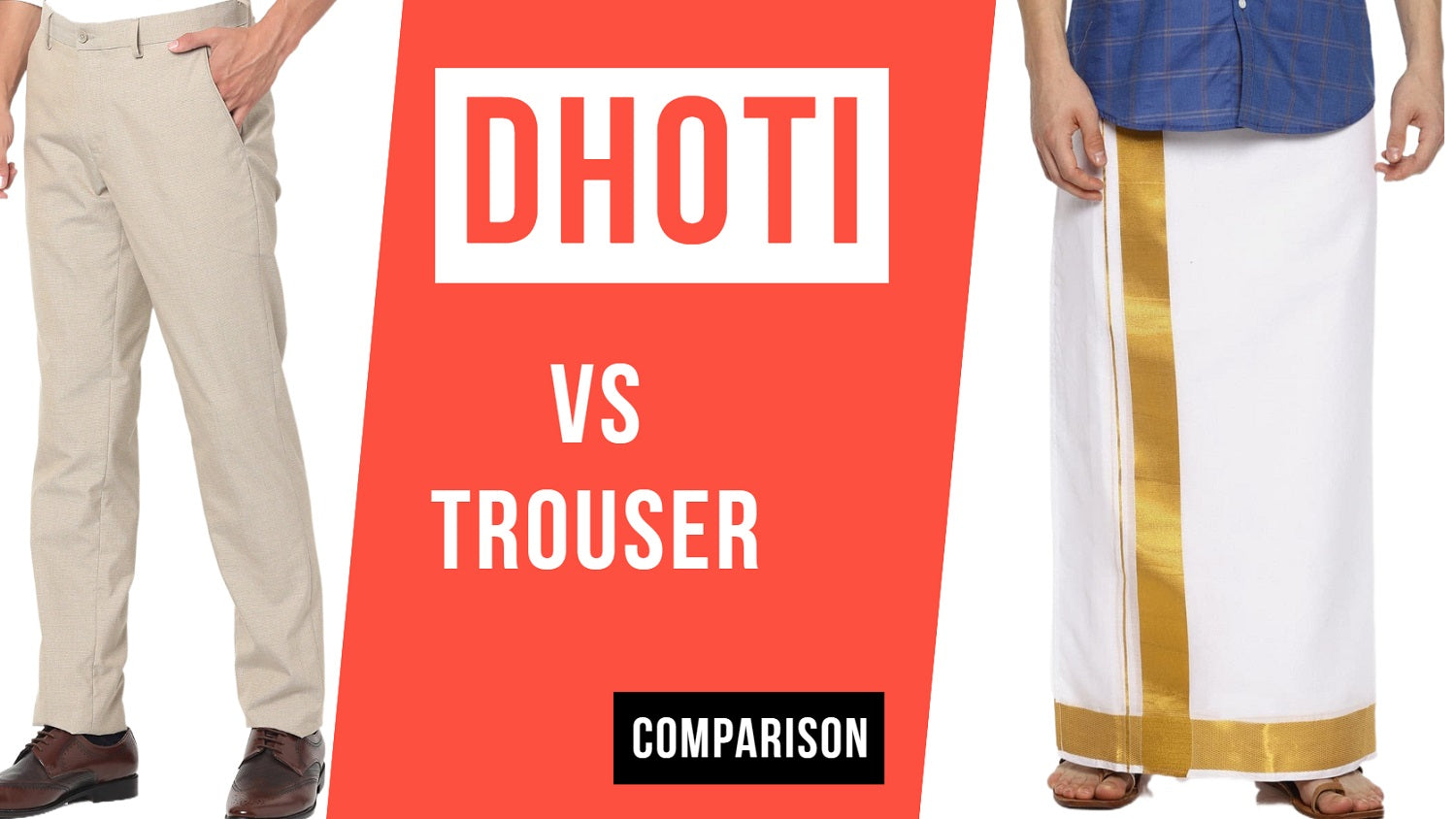Curious about the differences between a dhoti and a trouser? This detailed comparison will help you understand the unique features and cultural significance of both garments.
Dhoti and trousers are two distinct types of garments that have their own unique features and cultural significance. While trousers are commonly worn in Western cultures, dhotis are traditional garments worn in South Asian countries like India. This comparison will delve into the various aspects of both garments, including their style, fabric, and cultural significance, to provide a comprehensive understanding of their differences.
On the other hand, trousers have become a staple in Western fashion and are worn by people of all genders. They are often associated with modernity, professionalism, and formal attire. Trousers have evolved over time and have become a versatile garment that can be worn in various settings, from casual to formal. In many cultures, trousers are seen as a symbol of progress and Western influence.
It is important to note that the cultural significance of dhoti and trousers can vary within different regions and communities. While the dhoti may hold strong traditional and religious connotations in South Asia, trousers may be seen as a symbol of liberation and equality in other parts of the world. Understanding and appreciating the cultural significance of these garments can help foster cross-cultural understanding and appreciation.
Dhotis are typically made of lightweight and breathable fabrics such as cotton, making them suitable for hot and humid climates. The loose and flowing nature of the dhoti allows for ease of movement, making it comfortable for activities such as yoga, meditation, and traditional dances. However, the draping style of the dhoti may require some practice and skill to ensure it stays in place during physical activities.
On the other hand, trousers are often made of a variety of fabrics, including cotton, polyester, and wool, offering different levels of comfort and suitability for various climates. Trousers provide a more structured and fitted silhouette, which can be advantageous for activities that require a greater range of motion, such as sports or outdoor adventures. Additionally, trousers can be easily paired with different types of tops and footwear, allowing for versatility in styling.
In terms of climate, trousers offer more insulation and protection against colder temperatures compared to dhotis. They can be layered with other garments such as jackets or sweaters, making them suitable for colder climates. However, in hot and humid climates, trousers made of lightweight and breathable fabrics can still provide comfort.
Ultimately, the comfort and versatility of dhoti and trousers depend on personal preference, cultural context, and the specific activities and climates in which they are worn. Both garments have their unique features and can be appreciated for their cultural significance and practicality in different settings.
In recent years, designers have incorporated dhoti-inspired elements into Western clothing, creating fusion styles that blend traditional and modern aesthetics. Dhoti pants, for example, feature the draped silhouette of a dhoti but are tailored to resemble trousers, offering a more structured and streamlined look. These pants have gained popularity among both men and women, and can be styled in various ways to create unique and fashionable outfits.
Trousers, on the other hand, have undergone numerous transformations to keep up with changing fashion trends. From wide-legged palazzo pants to skinny jeans, there is a wide range of trouser styles available today. Designers have experimented with different cuts, fabrics, and embellishments to create trousers that cater to different fashion preferences and occasions.
In addition to these adaptations, both dhotis and trousers have also been embraced by the gender-neutral fashion movement. Many individuals are now challenging traditional gender norms and opting for clothing that allows them to express their personal style and identity. Dhotis and trousers, with their versatility and ability to be styled in various ways, have become popular choices for those seeking gender-neutral fashion options.
Overall, the fashion trends and contemporary adaptations of dhotis and trousers reflect the ever-changing nature of the fashion industry. Whether it's through fusion styles, innovative cuts, or gender-neutral fashion, both garments continue to be relevant and appreciated in the modern world.
Dhoti and trousers are two distinct types of garments that have their own unique features and cultural significance. While trousers are commonly worn in Western cultures, dhotis are traditional garments worn in South Asian countries like India. This comparison will delve into the various aspects of both garments, including their style, fabric, and cultural significance, to provide a comprehensive understanding of their differences.
Origin and History: Explore the origins and historical significance of dhoti and trousers.
The origins and historical significance of dhoti and trousers are fascinating to explore. The dhoti has a rich history dating back thousands of years and is deeply rooted in Indian culture. It is believed to have been worn by ancient Indian civilizations and has been a traditional garment for men in India for centuries. On the other hand, trousers have a more recent history and are commonly associated with Western fashion. They became popular in Europe during the Middle Ages and have since become a staple in Western clothing. Understanding the origins and historical significance of these garments can provide valuable insights into their cultural significance and evolution over time.Design and Structure: Compare the design, fabric, and construction of dhoti and trousers.
When comparing the design, fabric, and construction of dhoti and trousers, several key differences can be observed. The dhoti is typically made from a single piece of fabric, usually cotton, that is wrapped around the waist and legs. It is known for its loose and flowing nature, providing comfort and ease of movement. Trousers, on the other hand, are constructed with separate pieces of fabric for the waistband, legs, and sometimes pockets. They are typically made from materials such as denim, cotton, or polyester, offering a more structured and fitted silhouette. The construction of trousers often includes features such as zippers, buttons, and belt loops, allowing for easy wearing and adjustment. Overall, the design and structure of dhoti and trousers reflect the cultural and practical preferences of the regions they originate from.Cultural Significance: Discuss the cultural and traditional importance of dhoti and trousers in different regions and communities.
Both the dhoti and trousers hold significant cultural and traditional importance in different regions and communities. The dhoti is a traditional garment worn by men in South Asian countries such as India, Bangladesh, and Sri Lanka. It is often associated with religious ceremonies, weddings, and formal occasions. The dhoti holds symbolic value and is considered a mark of respect and tradition. In some communities, the style of draping the dhoti can also indicate the wearer's social status or caste.On the other hand, trousers have become a staple in Western fashion and are worn by people of all genders. They are often associated with modernity, professionalism, and formal attire. Trousers have evolved over time and have become a versatile garment that can be worn in various settings, from casual to formal. In many cultures, trousers are seen as a symbol of progress and Western influence.
It is important to note that the cultural significance of dhoti and trousers can vary within different regions and communities. While the dhoti may hold strong traditional and religious connotations in South Asia, trousers may be seen as a symbol of liberation and equality in other parts of the world. Understanding and appreciating the cultural significance of these garments can help foster cross-cultural understanding and appreciation.
Comfort and Versatility: Analyze the comfort and versatility of dhoti and trousers in various activities and climates.
When comparing the comfort and versatility of dhoti and trousers, it is important to consider the different activities and climates in which they are worn.Dhotis are typically made of lightweight and breathable fabrics such as cotton, making them suitable for hot and humid climates. The loose and flowing nature of the dhoti allows for ease of movement, making it comfortable for activities such as yoga, meditation, and traditional dances. However, the draping style of the dhoti may require some practice and skill to ensure it stays in place during physical activities.
On the other hand, trousers are often made of a variety of fabrics, including cotton, polyester, and wool, offering different levels of comfort and suitability for various climates. Trousers provide a more structured and fitted silhouette, which can be advantageous for activities that require a greater range of motion, such as sports or outdoor adventures. Additionally, trousers can be easily paired with different types of tops and footwear, allowing for versatility in styling.
In terms of climate, trousers offer more insulation and protection against colder temperatures compared to dhotis. They can be layered with other garments such as jackets or sweaters, making them suitable for colder climates. However, in hot and humid climates, trousers made of lightweight and breathable fabrics can still provide comfort.
Ultimately, the comfort and versatility of dhoti and trousers depend on personal preference, cultural context, and the specific activities and climates in which they are worn. Both garments have their unique features and can be appreciated for their cultural significance and practicality in different settings.
Fashion and Modern Trends: Examine the fashion trends and contemporary adaptations of dhoti and trousers in the modern world.
Fashion trends are constantly evolving, and both dhotis and trousers have seen their fair share of adaptations in the modern world. While dhotis are traditionally associated with Indian culture and are often worn for special occasions and religious ceremonies, they have also made their way into contemporary fashion.In recent years, designers have incorporated dhoti-inspired elements into Western clothing, creating fusion styles that blend traditional and modern aesthetics. Dhoti pants, for example, feature the draped silhouette of a dhoti but are tailored to resemble trousers, offering a more structured and streamlined look. These pants have gained popularity among both men and women, and can be styled in various ways to create unique and fashionable outfits.
Trousers, on the other hand, have undergone numerous transformations to keep up with changing fashion trends. From wide-legged palazzo pants to skinny jeans, there is a wide range of trouser styles available today. Designers have experimented with different cuts, fabrics, and embellishments to create trousers that cater to different fashion preferences and occasions.
In addition to these adaptations, both dhotis and trousers have also been embraced by the gender-neutral fashion movement. Many individuals are now challenging traditional gender norms and opting for clothing that allows them to express their personal style and identity. Dhotis and trousers, with their versatility and ability to be styled in various ways, have become popular choices for those seeking gender-neutral fashion options.
Overall, the fashion trends and contemporary adaptations of dhotis and trousers reflect the ever-changing nature of the fashion industry. Whether it's through fusion styles, innovative cuts, or gender-neutral fashion, both garments continue to be relevant and appreciated in the modern world.

